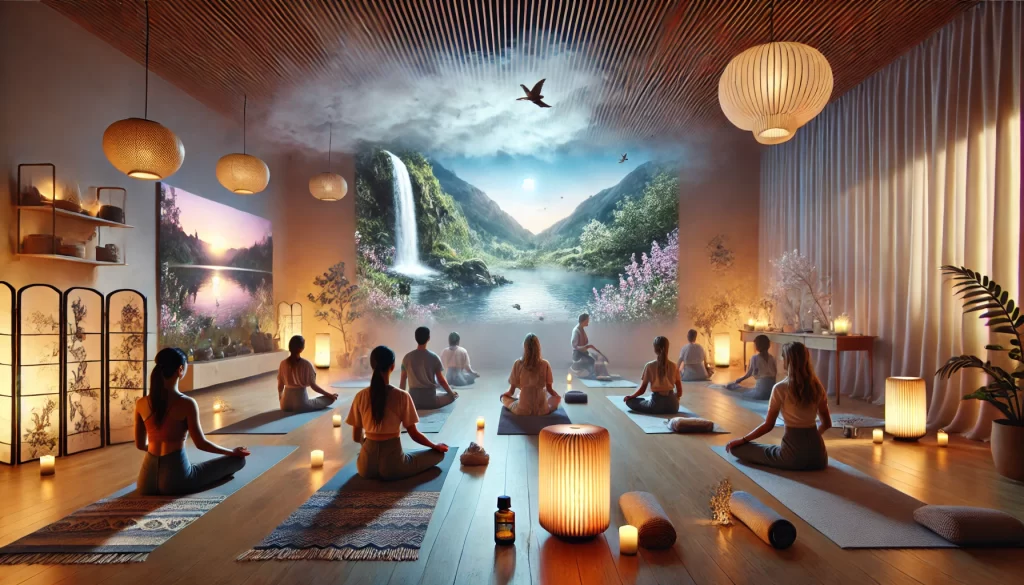How to Plan a Multisensory Yoga Class: A Guide for Instructors
Yoga is a holistic practice that engages the mind, body, and spirit. To enhance the experience for practitioners, integrating multisensory elements—such as sound, lighting, and visual projections—can create a deeper connection and improve focus. A well-structured multisensory yoga class can elevate the practice, making it more immersive and transformative.
In this guide, we’ll explore how yoga instructors can design classes using different sensory elements to create an unforgettable experience for their students.
1. Understanding Multisensory Yoga
Multisensory yoga involves incorporating multiple sensory modalities to enhance the physical and meditative aspects of the practice. The key senses that can be engaged include:
- Auditory (Sound): Music, nature sounds, singing bowls, or mantras.
- Visual (Sight): Lighting, color schemes, projections, or nature-inspired visuals.
- Tactile (Touch): Textured mats, props, temperature adjustments.
- Olfactory (Smell): Aromatherapy, essential oils, incense.
- Gustatory (Taste): Herbal teas or refreshing drinks post-session.
By integrating these elements thoughtfully, yoga instructors can create a harmonious and deeply engaging experience.
2. Planning a Multisensory Yoga Session
Step 1: Define the Theme and Intention
Before adding multisensory elements, define the goal of your class. Is it relaxation, energy boosting, emotional healing, or deep meditation? The theme will guide your choices for sound, lighting, and other sensory additions.
Examples:
- Calm & Restore: Soft lighting, slow music, lavender scent.
- Energizing Flow: Bright lighting, upbeat rhythm, refreshing citrus aroma.
- Deep Meditation: Dimmed lights, minimal sounds, earthy scents.
Step 2: Curate the Auditory Experience
Sound plays a crucial role in setting the mood of a class. Consider using:
- Soft instrumental music for relaxation.
- Binaural beats or Tibetan bowls for deeper meditation.
- Chants or mantras to enhance concentration.
- Nature sounds (rain, ocean waves, birds) for a grounding experience.
- Silence—sometimes the absence of sound can be the most powerful tool.
Step 3: Create the Right Visual Ambience
Lighting and visuals can significantly affect emotions and energy levels. Some effective ways to use visuals include:
- Dimmed or candlelit lighting for evening classes.
- Natural sunlight or soft white lighting for morning sessions.
- Color therapy lighting (blue for calm, orange for energy, green for balance).
- Projection of nature scenery to create a tranquil environment.
- Minimal distractions—ensure the space is clean and visually calming.
Step 4: Enhance the Tactile Experience
Touch can influence relaxation and grounding. Consider the following:
- Provide soft blankets, pillows, and bolsters for comfort.
- Use textured yoga mats or incorporate grounding elements like sand or grass for outdoor sessions.
- Adjust room temperature to match the theme (warm for relaxation, cool for invigoration).
Step 5: Engage the Sense of Smell
Scents can trigger emotions and set the tone for your class. Some options include:
- Lavender, chamomile, or sandalwood for relaxation.
- Citrus, peppermint, or rosemary for energy.
- Frankincense or sage for meditation and cleansing.
Use essential oil diffusers, incense, or scented candles, but always check for allergies or sensitivities among students.
Step 6: Conclude with a Taste Experience
While taste is not typically part of yoga, offering a post-session herbal tea can extend the multisensory experience. Suggestions include:
- Chamomile or mint tea for relaxation.
- Ginger or lemon tea for detoxification.
- Coconut water for refreshment after an intense flow.
3. Tips for a Seamless Experience
- Keep it balanced: Avoid overwhelming students with too many sensory elements.
- Test beforehand: Ensure all sensory elements work well together.
- Encourage mindfulness: Guide students to consciously experience each sense.
- Gather feedback: Ask participants about their experience to refine future classes.
Conclusion
Multisensory yoga classes can elevate the yoga experience, making it more engaging and transformative. By integrating sound, visuals, touch, scent, and taste, instructors can create an environment that supports relaxation, energy flow, and deep meditation.
By planning with intention and sensitivity, you can craft a yoga session that resonates with all the senses, leaving students feeling refreshed, balanced, and deeply connected to their practice.
Tips for Yoga Masters:
- Start Small: Begin with a few elements and expand gradually.
- Collaborate: Work with sound designers or visual artists to enhance the experience.
- Gather Feedback: Adjust based on student experiences.
- Stay Authentic: Keep the essence of yoga at the center of your practice.
Here you can see some useful tools that are suitable for your yoga classes:
Bluetooth Sound Machine with Nature Sounds
Essential Oil Diffuser for Yoga & Meditation
Natural Incense Sticks & Holders

